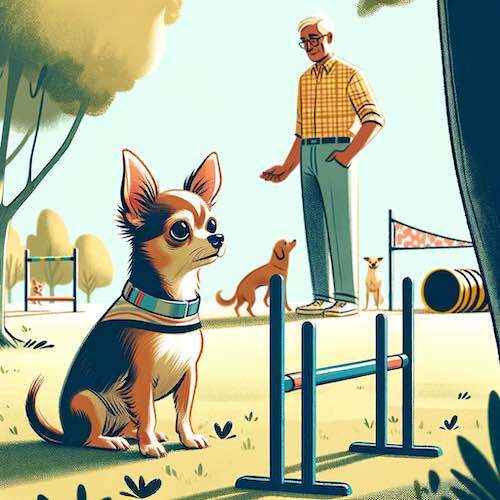Chihuahua Food Aggression: Understanding the Causes, Recognizing the Signs, and Safe Training Methods
While known for their spirited personalities and outsized confidence, even the most charming Chihuahua can struggle with food aggression. This behavior might seem surprising in such a small dog, but it’s important to remember that a Chihuahua’s world is very different from our own. To them, food isn’t just a tasty meal – it represents survival. Understanding the motivations behind food aggression, recognizing the subtle signs unique to Chihuahuas, and implementing safe, positive training techniques are key to building a happier and more trusting relationship with your tiny companion.
Imagine yourself shrunk down to the size of a Chihuahua. Suddenly, the world becomes a place of giants. Hands that mean petting and cuddles can also seem to tower above, potentially threatening to take away your most valuable resource. This sense of vulnerability, paired with instincts honed over thousands of years, can lead even the sweetest Chihuahua to feel protective of their food.
Search: Best Selling Chihuahua Products Online
Additionally, a Chihuahua’s past experiences play a significant role. If they experienced inconsistent meals, competition with littermates, or even unintentional reinforcement of guarding behaviors, these anxieties can manifest as food aggression. Recognizing these underlying factors allows us to approach their behavior with empathy, not judgment.
By learning the subtle signals of a worried Chihuahua, understanding their perspective, and using positive training to build trust around food, you foster a deep bond. This lets your Chihuahua’s true personality shine, no longer overshadowed by fear.
Understanding Why: The Roots of Chihuahua Food Aggression
-
Size Matters: Chihuahuas live in a world of giants. Their small stature can make them feel acutely vulnerable, especially when it comes to something as essential as food. This instinctual need to protect resources might be heightened compared to larger breeds.
-
Early Experiences: If a Chihuahua puppy came from a competitive litter, had unreliable access to meals, or simply wasn’t fed in a way that created a sense of security, they might develop anxieties around food that carry into adulthood.
-
Accidental Lessons: A Chihuahua whose grumbles or body language cause people to back away learns that this behavior successfully keeps their food safe. Even if they were initially acting from fear, they may continue the behavior because it “works.”
-
Medical Matters: Pain or underlying health issues can make any dog more irritable and defensive. A veterinary checkup is crucial to rule out medical factors contributing to a Chihuahua’s food aggression.
-
Anxiety and Environment: Chihuahuas can be sensitive souls. Chaotic households, changes in routine, or a lack of clear leadership may create anxiety that spills over into resource guarding behaviors.
The Chihuahua Tell: Recognizing the Signs
Chihuahuas might telegraph their food guarding tendencies with the same behaviors as larger dogs, just on a smaller scale. Don’t underestimate the significance of these cues:
-
The Stare: Watch for eyes widening and an intense, unwavering focus on anyone approaching their food. This isn’t the happy gaze of a relaxed dog, but rather a sign of heightened alertness and potential defensiveness.
-
Body Language: Though they can’t intimidate with size, a food-guarding Chihuahua might stiffen their body, raise their tail slightly, or tuck it close in fear. Their hackles might also be up, giving the appearance of a slightly larger dog.
-
Beyond the Growl: Pay attention to pinned-back ears, a wrinkled nose with teeth exposed, or a quick, tense tail movement. These are all warning signs, even if they seem less imposing than in a large breed.
-
The Yap is Real: A Chihuahua’s growl, or their signature high-pitched yap, might lack the deep rumble of a Rottweiler, but it’s a serious indicator of discomfort and a request to back off.
Step One: Safety and Management
-
Prevention is Powerful: Even if you have a single Chihuahua, feeding them separately creates a sense of calmness and reduces the potential for resource competition. Puzzle feeders and slow-feed bowls can help turn mealtime into an enriching activity rather than a free-for-all.
-
Avoid Punishment: Yelling, scolding, or physical reprimands will only worsen the problem. This creates fear, leading your Chihuahua to hide their warning signs – potentially leading to bites without obvious cues.
-
A Vet Visit is Key: Ruling out medical issues gives you a clearer picture of your dog’s behavior and ensures any underlying health needs are being addressed.
-
Control the Environment: Initial management might involve feeding your Chihuahua in a separate, quiet room or a positively-associated crate. This ensures safety for everyone and reduces stress for your dog.
The Path to Trust: Training Techniques
Training your Chihuahua to relax around food focuses on creating positive associations and rewarding cooperation, not conflict. Here’s where to start:
-
Counterconditioning: Begin by tossing amazing treats (tiny bits of cheese, chicken, etc.) at a distance from your Chihuahua while they eat. Gradually move closer, always maintaining a calm, non-threatening presence. You’re teaching them that people near their food mean good things happen.
-
“Hand for a Paw”: Practice rewarding your Chihuahua generously for coming to your hand. Later, briefly remove their bowl, add a high-value treat, and return it immediately. They’ll learn that relinquishing something temporarily means getting something even better.
Absolutely! Here are a few directions we can explore to continue generating content about Chihuahuas and food aggression:
Focus on Specific Scenarios
-
Managing Multiple Chihuahuas: Delve into the dynamics of food aggression when multiple Chihuahuas live in the same household. This could include discussions of staggered/separate feeding times, teaching a strong “leave it” cue, and the spatial management of meal zones.
-
Young Children in the Home: Create a child-focused guide for understanding a Chihuahua’s body language around food. Safety tips, teaching toddlers respectful interaction, and ways to supervise meals would be essential.
-
Travel and Food Aggression: Discuss managing resource guarding tendencies while traveling. Considerations could include safe feeding options in new environments, crate training as a travel tool, and managing stress to prevent outbursts.
-
Addressing Mistakes: “Oops, I Hand-Fed My Anxious Chihuahua!” Provide strategies for reversing negative associations with hand-feeding and explore alternative ways to provide comfort around meals.
Advanced Training Techniques
-
“Go To Your Mat”: Help owners teach their Chihuahua a reliable “go to your mat” behavior that can create distance when tensions arise around food, allowing for safe meal management and redirection opportunities.
-
Resource Exchange Games: Beyond “Drop it,” outline other engaging games designed to teach a Chihuahua that giving up something valuable leads to even better rewards. This builds trust in a way that directly translates to food situations.
-
Distraction and Redirection Techniques: Discuss how to utilize play, positive interrupters (“Let’s Go!), and alternative reinforcers to redirect a Chihuahua’s attention away from potential conflict around mealtime.
Additional Resources and Information
-
Finding Professional Help: Guide owners on choosing a qualified dog trainer, behavior consultant, or veterinary behaviorist who has experience with resource guarding and the specific anxieties of small dogs.
-
The Emotional Side: Helping Owners Cope: Discuss the emotional toll food aggression can take on owners, emphasizing the importance of self-care and the understanding that fear, not ‘bad behavior,’ often drives the Chihuahua’s response.
-
Breed-Specific Resources: Provide a list of reputable websites, rescues, and online communities specializing in Chihuahuas. These networks often have experienced volunteers and foster homes well-versed in the nuances of managing food guarding in the breed.



